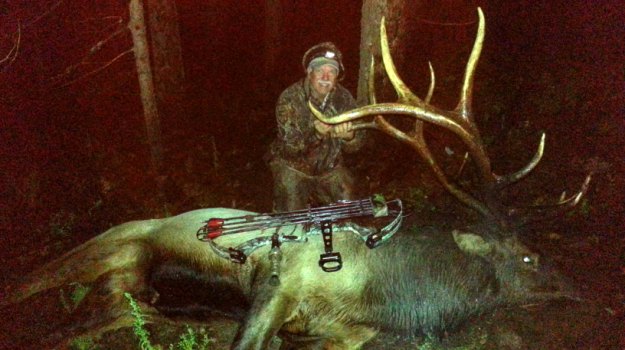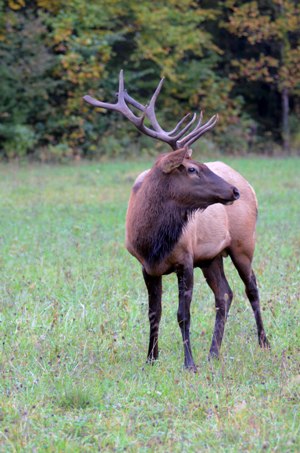
Editor’s Note: Mark Hanson lives in Mesa, Arizona, and has been a Mossy Oak ProStaffer for 7 years. His favorite Mossy Oak camo pattern is Treestand. “I like Treestand because I hunt in a lot of dark timber, high in the mountains, and on land that has been burned. Mossy Oak Treestand fits in every type terrain that I hunt.”
I've taken all the elk I've killed in Arizona with my bow. In 1999, I took my biggest bull elk, but I killed my first elk in 1984. He was a small bull, and I was hunting in Unit 5B south on the east side of Nevada, near the New Mexico border. Normally, we don’t see many elk over there - not because the elk don’t live there, but because the vegetation is so thick, and the terrain homes numbers of canyons, making where a bull comes from or goes to difficult to see.
The weekend before elk season began my son, Gonzales, and I went to scout the unit I had drawn - Unit 27. This unit is really rugged, and most people don’t put in to draw this unit. But I was fortunate enough to draw an elk tag for this unit. I also drew a tag for this unit for the next 4 out of 5 years. The first year I only had one weekend to hunt, and I took a 5x5 bull. The next bull I took out of this unit scored about 260. The following year I took a bull that scored 300. So, this was my fourth year to hunt this same unit. Often, an archer will draw this unit one or two times. After they’ve hunted it for a couple of years without much success, they’ll put in to draw another unit where they hope to find flatter ground. I prefer to hunt this area,since it has a lot of high country, spruce and aspen trees. When I'm hunting in the high county, I really feel like I'm elk hunting.
On this hunt, we were hunting deer as well as scouting for elk. We woke up one morning in camp on the edge of a wilderness area and heard this bull bugle. Quickly, we left camp and started hiking trying to find this bull. We located this bull with about 10 cows. Finally, we were able to move within 30 yards, and we watched the bull raking his antlers against a young tree. I was able to identify the bull because he was a 6x6, and he had a 7th point right at the end of one of his beams.
 The next week on Friday, when the season opened, I went back to the same spot. I was hunting by myself and playing cat-and-mouse with this herd. However, I couldn’t get in close enough for a shot at the bull. Finally, bad weather moved in, raining and hailing. I returned to camp. For the afternoon hunt, I decided I’d go to a different area to see if I could call in another bull. When I started calling, I spotted a monster 8x8 bull, but the light was fading. I probably only had another 5 minutes of shooting light, so I decided to take the shot. I completely missed the bull; I didn’t even cut a hair. I went back to camp discouraged. Here I’d been on two trophy bulls but I didn’t take either one of them. I completely missed the biggest bull.
The next week on Friday, when the season opened, I went back to the same spot. I was hunting by myself and playing cat-and-mouse with this herd. However, I couldn’t get in close enough for a shot at the bull. Finally, bad weather moved in, raining and hailing. I returned to camp. For the afternoon hunt, I decided I’d go to a different area to see if I could call in another bull. When I started calling, I spotted a monster 8x8 bull, but the light was fading. I probably only had another 5 minutes of shooting light, so I decided to take the shot. I completely missed the bull; I didn’t even cut a hair. I went back to camp discouraged. Here I’d been on two trophy bulls but I didn’t take either one of them. I completely missed the biggest bull.
That night Gonzales drove into camp. The next morning we went over to the spot where we had seen the big bull with 10 cows. Just as we got out of the truck, we heard an elk bugle about 200 yards away. We grabbed our day packs, I grabbed my bow, and we ran up a trail that brought us within about 100 yards of where the bull had been bugling. We set up just off the trail and soon saw cows coming down the trail. I got ready to draw and shoot. When we saw the cows, I hadn’t blown a cow call or a bugle. Right behind the cows about 25 yards off the trail, I saw the bull. We actually had patterned this bull, and we knew what he liked to do early in the morning. The bull and his cows would feed in a meadow at night. At first light, they’d leave the meadow, go up the trails onto a ridge and then head down into a wilderness area to spend the day. When I finally could see the bull, I knew he was the same bull that Gonzales and I had seen the week before. He had that 7th point on one of his antlers. But by then, he had broken off a portion of that point. I waited for the bull to present the shot, and I released the arrow. When the bull took the broadhead, he only went about 80 yards before he piled up. His rack grossed 368 points and netted 360 points. So, he was very symmetrical.
Where the bull fell was convenient for us, because I could drive my truck right up to the bull. We caped, quartered and put the rest of the meat in the back of the truck without having to do any packing out. A friend of mine was coming into camp on Saturday afternoon. By the time he got to camp, we had the hide off the quarters and had all the meat in bags hanging high in the trees.
To learn more about hunting, check out John E. Phillips’ new eBook and print book, “Bowhunting Deer: Mossy Oak Pros Know Bucks and Bows.” You also can download a free Kindle app that enables you to read the book on your iPad, computer or Smartphone.
For information on making jerky from your elk to provide a protein-rich snack, you can download a free book from http://johninthewild.com/free-books.
Day 3: Hunting Mule Deer and Cow Elk
Tomorrow: The Hunt for the 363-Point Bull



























